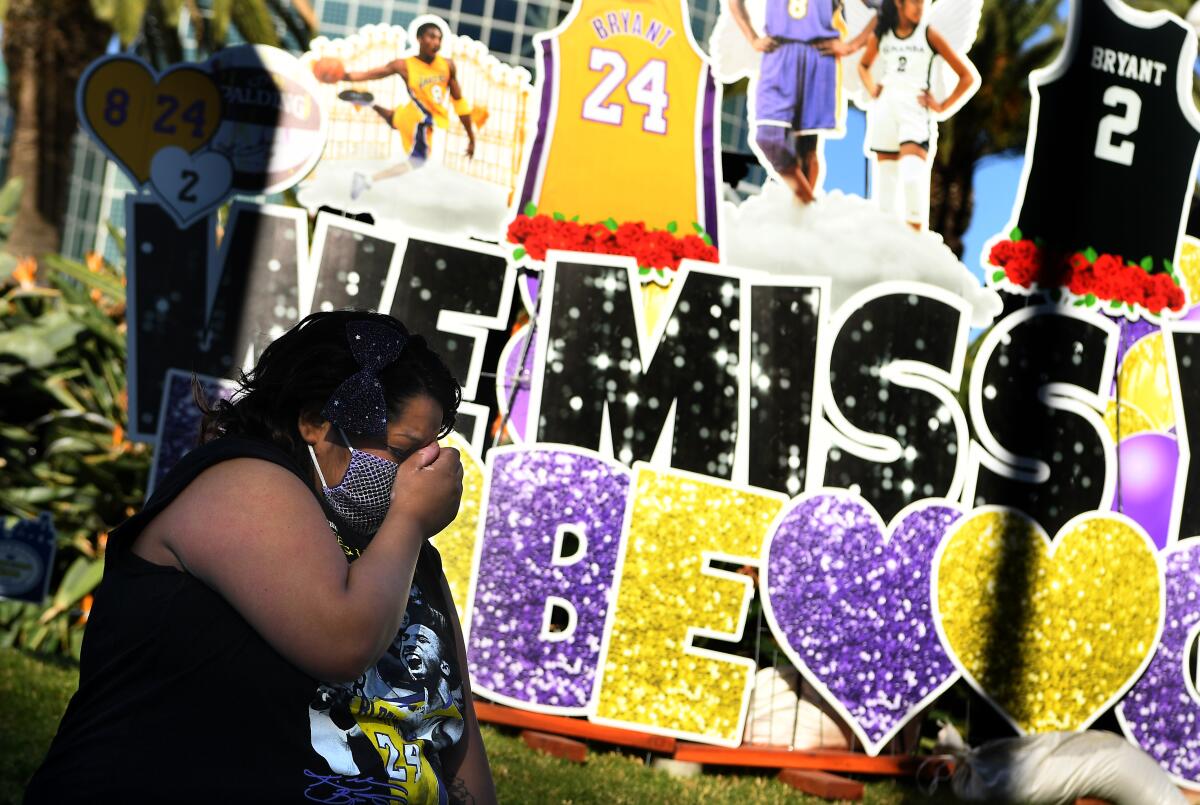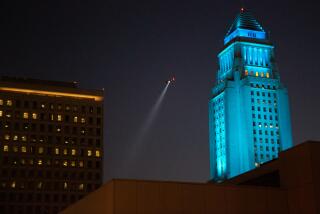What caused the Kobe Bryant helicopter crash? Investigators are about to reveal answers

- Share via
Why did the helicopter carrying Los Angeles Lakers legend Kobe Bryant, his daughter Gianna and seven others crash into a fog-covered hillside in Calabasas a year ago, killing all on board?
The National Transportation Safety Board on Tuesday will make a probable cause finding and give recommendations to those who regulate the sky to avoid a repeat of the Jan. 26, 2020, crash. The deadly crash not only unleashed a tidal wave of grief but a plethora of lawsuits and congressional efforts to legislate for better helicopter safety.
In the year since, Vanessa Bryant, Kobe’s widow and Gianna’s mother, and other passengers’ families have in court accused pilot Ara Zobayan and Island Express of flying in dangerous weather conditions. The helicopter operator has in turn pointed the finger at the air traffic controllers and at the weather as an act of God.
The more than 1,700 pages of investigative documents that examine all aspects of the crash of the chopper, however, strengthened a widely held view among helicopter experts that the pilot may have become disoriented while he navigated through fog-covered terrain on the Sunday morning flight from Orange County to Camarillo. There were no signs of mechanical failure on the flight carrying parents, coaches and players to a youth basketball game at Bryant’s then Mamba Academy.
Zobayan told air traffic control they were “climbing” to 4,000 feet when in reality the aircraft was descending. The NTSB’s aircraft performance study said the helicopter banked left and away from the 101 Freeway while communicating with the controller. According to the study, the pilot “could have misperceived both pitch and roll angles,” according to the NTSB documents.
“When a pilot misperceives altitude and acceleration it is known as the ‘somatogravic illusion’ and can cause spatial disorientation,” the report said. In other words, acceleration could cause a pilot to sense his helicopter was climbing when it was not.
In this case, experts say the greater controversy may surround the NTSB recommendations to improve helicopter safety to the Federal Aviation Administration, which sets the rules and has often rejected calls for new chopper regulations.
Such large turbine helicopters are not required to have a terrain awareness warning system, known as TAWS, to alert a pilot if they are about to fly into rising topography. Nor must they have flight data or cockpit voice recorders.
The board may reiterate its recommendations to close those loopholes. It first called for the warning system 15 years after a similar Sikorsky crashed into the Gulf of Mexico, killing 10 on board.
Sikorsky had voluntarily begun installing the system in its new versions of the S-76 helicopter. It also offered retrofits on older helicopters like the 1991 Sikorsky S-76B that carried the Bryants, Christina Mauser; Payton and Sarah Chester; John, Keri and Alyssa Altobelli; and Zobayan. Although it mandated the system for air ambulances in 2014, the FAA has rejected that call.
Jennifer Homendy, an NTSB board member who led the on-scene investigation, has already said terrain awareness may have helped inform the pilot of his nearness to the ground but investigators have been careful not to say it would have prevented the crash. She also noted the investigation was hindered by a lack of flight data recorder and voice cockpit recorder, another longtime recommendation of the board on such large passenger choppers.
Former Island Express pilot Kurt Deetz said given the topography in the L.A. region, a terrain system that gives visual and verbal warnings does not help in cases like this one. Experts note the pilot had a radar altimeter and his angle of descent meant he was not going to be able to suddenly pull up when he crashed into the hillside near Las Virgenes Road and Willow Glen Street at 9:45 a.m. about 1,000 feet above sea level.
Nonetheless, Sen. Dianne Feinstein (D-Calif.) and U.S. Rep. Brad Sherman (D-Northridge) are pushing to require terrain systems in larger helicopters and so-called black boxes. James Viola of the Helicopter Assn. International called it “a one solution fits all” method that could make matters worse.
Some other experts say the NTSB may tackle the complexity of the big Sikorsky and the need for two pilots in tough weather conditions. Doug Solbrekken, who flew the Sikorsky S-76 as a medical flight pilot in Canada, said the loss of situation awareness by the pilot was because the aircraft is designed to be flown by two instrument flight trained pilots to be safe in all weather. “Spending the money, crew the aircraft with IFR trained pilots and be safe,” he said.
A witness on a mountain bike trail in Calabasas told investigators that the area was “surrounded by mist” and that he heard the sound of a helicopter and saw a blue and white chopper emerge from the clouds, passing from left to right. The NTSB reports noted that videos and photos from the public “depict fog and low clouds obscuring the hilltops.” The reports noted that the pilot had struggled with a “low cloud ceiling.”
The NTSB’s operational factors and human performance report said, “Evidence of the accident pilot receiving a weather briefing from an approved source could not be determined.”
The night before the crash, the broker arranging the flight had expressed concerns to the pilot that “weather could be an issue.” Zobayan assured the broker the next morning that it “should be ok,” according to text messages released by the NTSB.
Text messages recently released by the National Transportation Safety Board reconstruct helicopter crash that killed Kobe Bryant, his daughter Gianna and seven others.
Vanessa Bryant is suing Island Express, with her lawyers arguing that it did not adequately train and supervise Zobayan, its lead pilot, and that he was careless and negligent in his flying.
In a cross-complaint filed in Los Angeles County Superior Court, Island Express Helicopters and Island Express Holding Corp. alleged that “a series of erroneous acts and/or omissions” by the flight controllers resulted in the crash. The controllers work for the Federal Aviation Administration’s Southern California TRACON, which handles flights in the region.
Island Express alleges a flight controller improperly declined Zobayan’s request for flight following — a procedure in which a controller gives assistance as a pilot tackles difficult conditions.
FAA officials have said that procedure could not be maintained because radar could not track the Sikorsky through the topography. The lawsuit by Island Express against the flight controller alleges radar tracking was not lost and a first controller in L.A. airspace did not brief a second controller who took over about the chopper and that the pilot believed he was still being given guidance with tracking.
The hearing is scheduled for 9:30 a.m. EST in Washington, D.C., and will be webcast. A link to the webcast will be available shortly before the start of the meeting at ntsb.windrosemedia.com/.
More to Read
Sign up for Essential California
The most important California stories and recommendations in your inbox every morning.
You may occasionally receive promotional content from the Los Angeles Times.












